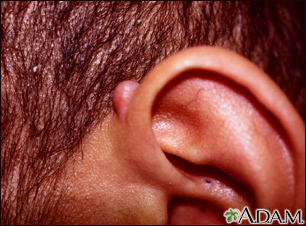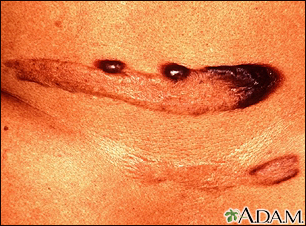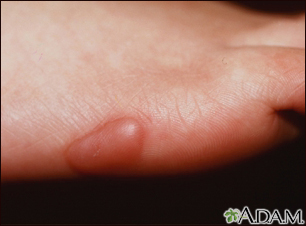Keloids
Keloid scar; Scar - keloid
A keloid is a growth of extra scar tissue. It occurs where the skin has healed after an injury.
Images



I Would Like to Learn About:
Causes
Keloids can form after skin injuries from:
- Acne
- Burns
- Chickenpox
- Ear or body piercing
- Minor scratches
- Cuts from surgery or trauma
- Vaccination sites
Keloids are most common in people younger than 30. Black people, Asians, and Hispanics are more prone to developing keloids. Keloids often run in families. Sometimes, a person may not recall what injury caused a keloid to form.
Symptoms
A keloid may be:
- Flesh-colored, red, or pink
- Located over the site of a wound or injury
- Lumpy or ridged
- Tender and itchy
- Irritated from friction such as rubbing on clothing
A keloid will tan darker than the skin around it if exposed to the sun during the first year after it forms. The darker color may not go away.
Exams and Tests
Your health care provider will look at your skin to see if you have a keloid. A skin biopsy may be done to check for other types of skin growths (tumors).
Treatment
Keloids often do not need treatment. If the keloid bothers you, discuss your concern with a skin specialist (dermatologist). Your dermatologist may recommend these treatments to reduce the size of the keloid:
- Corticosteroid injections
- Freezing (cryotherapy)
- Laser treatments
- Radiation
- Surgical removal
- Silicone gel or patches
These treatments, especially surgery, sometimes cause the keloid scar to become larger.
Outlook (Prognosis)
Keloids usually are not harmful to your health, but they may affect how you look.
When to Contact a Medical Professional
Contact your provider if:
- You develop keloids and want to have them removed or reduced
- You develop new symptoms
Prevention
When you are in the sun:
- Cover a keloid that is forming with a patch or adhesive bandage.
- Use sunblock.
Continue to follow these steps for at least 6 months after injury or surgery for adults. Children may need up to 18 months of prevention.
Imiquimod cream may help prevent keloids from forming after surgery. The cream may also prevent keloids from returning after they are removed.
Related Information
ChickenpoxAcne
References
Dinulos JGH. Benign skin tumors. In: Dinulos JGH, ed. Habif's Clinical Dermatology. 7th ed. Philadelphia, PA: Elsevier; 2021:chap 20.
Machan S, Molina-Ruiz AM, Requena L. Dermal hypertrophies. In: Bolognia JL, Schaffer JV, Cerroni L, eds. Dermatology. 5th ed. Philadelphia, PA: Elsevier; 2025:chap 98.
Patterson JW. Disorders of collagen. In: Patterson JW, ed. Weedon's Skin Pathology. 5th ed. Philadelphia, PA: Elsevier; 2021:chap 12.
BACK TO TOPReview Date: 10/13/2024
Reviewed By: Ramin Fathi, MD, FAAD, Director, Phoenix Surgical Dermatology Group, Phoenix, AZ. Also reviewed by David C. Dugdale, MD, Medical Director, Brenda Conaway, Editorial Director, and the A.D.A.M. Editorial team.

Health Content Provider
06/01/2025
|
A.D.A.M., Inc. is accredited by URAC, for Health Content Provider (www.urac.org). URAC's accreditation program is an independent audit to verify that A.D.A.M. follows rigorous standards of quality and accountability. A.D.A.M. is among the first to achieve this important distinction for online health information and services. Learn more about A.D.A.M.'s editorial policy, editorial process and privacy policy. A.D.A.M. is also a founding member of Hi-Ethics. This site complied with the HONcode standard for trustworthy health information from 1995 to 2022, after which HON (Health On the Net, a not-for-profit organization that promoted transparent and reliable health information online) was discontinued. |
The information provided herein should not be used during any medical emergency or for the diagnosis or treatment of any medical condition. A licensed medical professional should be consulted for diagnosis and treatment of any and all medical conditions. Links to other sites are provided for information only -- they do not constitute endorsements of those other sites. © 1997- 2025 A.D.A.M., a business unit of Ebix, Inc. Any duplication or distribution of the information contained herein is strictly prohibited.
